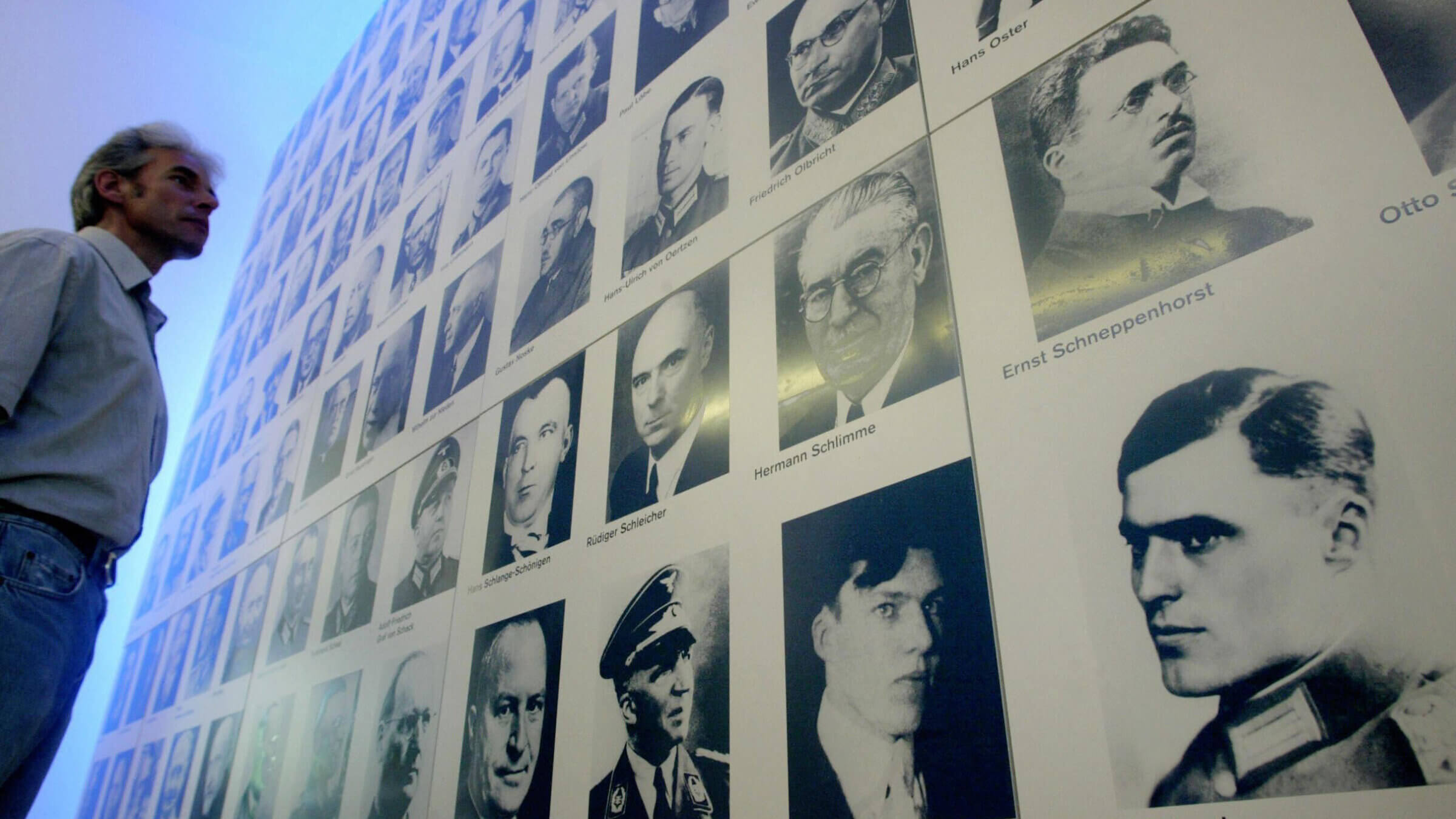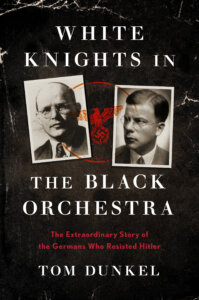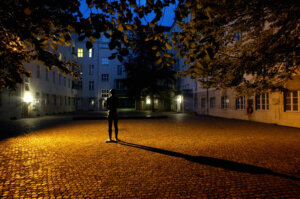The courageous German ‘orchestra’ that tried (and failed) to stop Hitler
Tom Dunkel’s absorbing history chronicles the little-known exploits of the Germans’ resistance in WWII

In Berlin, a wall of photos displays members of the resistance who plotted a 1944 assassination attempt against Hitler. Photo by Getty Images
White Knights in the Black Orchestra: The Extraordinary Story of the Germans Who Resisted Hitler
By Tom Dunkel
Hachette Books, 464 pages, $32
Last year, Rebecca Donner’s gripping biography, “All the Frequent Troubles of Our Days,” explored her American great-great-aunt’s exploits in the anti-Nazi resistance. With her German husband, Arvid, Mildred Harnack was active in the leftist opposition and spy circles that the Third Reich disdainfully dubbed the “Red Orchestra” and eventually crushed.
For students of the generally underappreciated (and mostly unsuccessful) German resistance, Tom Dunkel’s “White Knights in the Black Orchestra” makes an indispensable companion read.
Despite our knowledge of the arc of history, Dunkel’s nonfiction narrative is surprisingly suspenseful, as well as elegantly written. Deftly interweaving divergent stories, Dunkel emphasizes ironies and unforeseen twists as his characters navigate Nazi bureaucracies, shifting ideological currents and the pressures of war.
Like Donner’s book, “White Knights in the Black Orchestra” is a tale of great heroism, shadowed by villainy and mixed motives, at a time and place when the moral stakes could not have been higher.

Among Dunkel’s protagonists, most of them German government officials or military leaders, are reformed or wavering Nazis. (Some had themselves committed war crimes, a narrative thread Dunkel doesn’t pursue.) Many, in contrast to Red Orchestra members, had conservative or authoritarian views.
Their motivations for rejecting the regime varied. Some had opposed Hitler from the start. Others were repelled by his increasingly disastrous war and the mounting barbarism in its wake, including the mass deportation and slaughter of European Jews.
Black Orchestra resisters (again, a Nazi label, rather than their own) looked not to the Soviet Union, but to Britain and the United States, for assistance. But the Allies, despite numerous approaches, remained suspicious and intent on unconditional surrender. Concrete help never materialized, to Dunkel’s unconcealed dismay.
One base of resistance operations was Germany’s Abwehr, the regime’s highly competent intelligence service. Oskar Schindler, later a famous Holocaust rescuer, was an Abwehr agent in Czechoslovakia. The agency’s head was Admiral Wilhelm Canaris, “a quirky character seemingly lifted from a Charles Dickens novel,” a man who “disliked violence, tall people, and anyone with small ears.”
At his side were Colonel Hans Oster, the agency’s “traffic controller,” and Hans von Dohnanyi, a lawyer with one Jewish grandparent. Dohnanyi compiled a “Chronicle of Shame” detailing Nazi abuses and crimes, evidence that he grew frantic to hide and then destroy. Dunkel calls the chronicle “the sheet music of the Black Orchestra.”
These dissenters helped some Jews escape Germany and repeatedly tried to warn the Allies of Nazi invasion plans. In concert with an ever-changing array of military leaders, civil servants and others, they also plotted, abandoned and botched various coups.

The earliest, planned for 1938 and 1939, would have derailed the Third Reich and averted the Holocaust. But the circumstances were never favorable, or so the generals concluded. After all, Germany’s victories in those years were swift, if not bloodless, and Hitler’s popular support remained strong. “Soldiers on those kinds of winning streaks aren’t inclined to stick their necks out and commit treason,” Dunkel writes.
An unrelated lone assassin — Georg Elser, a carpenter with Communist sympathies — tried to blow up Hitler in Munich in November 1939. Two Black Orchestra efforts to kill Hitler, in March 1943, also fizzled.
The German resistance is best known for its July 20, 1944, assassination attempt against Hitler and his henchmen at his Wolf’s Lair headquarters in East Prussia. With Germany headed for a catastrophic loss in the war, Operation Valkyrie was late and desperate, a last-chance marker laid down for history. At its center was Colonel Claus von Stauffenberg, maimed in battle, who had to arm a bomb with only three fingers. (Could no one more suitable – and sufficiently brave — be found? Apparently not.)
The conspirators’ goals included overthrowing the Nazi government, installing a new regime, and negotiating for peace with the Allies, who would finally realize that the resistance was serious.
It was also unlucky. Stauffenberg left a bomb-containing briefcase in a conference room with Nazi leaders, then left — and another officer “inadvertently” moved the bomb. As a result, Hitler survived the blast and, unsurprisingly, vented his rage on the conspirators. Along with about 5,000 relatives, sympathizers and other unfortunates, they were hunted down, tortured, executed, or forced to commit suicide without any semblance of a fair trial.
One linchpin of Dunkel’s narrative is Dietrich Bonhoeffer, “a German theologian on a fast track” who helped found Germany’s anti-Nazi Confessing Church. As Dohnanyi’s brother-in-law and a distant cousin of Arvid Harnack, he had links to a wide variety of resisters. After Hitler’s 1933 assumption of power, the well-connected Bonhoeffer had opportunities to stay in the United States or England but kept returning home. In a bid to escape the military draft, he joined the Abwehr, traveling around Europe on behalf of the dissident cause.

A 1943 raid on the Abwehr swept up Dohnanyi and Bonhoeffer, among others. In prison, the Protestant pastor produced voluminous writings, including poetry, plays and theological works, and exchanged letters with his young fiancee, Maria von Wedemeyer. That literary cornucopia enables Dunkel to tell Bonhoeffer’s story in vivid detail.
Another compelling character is Harald Poelchau, a prison chaplain who ministered to the condemned — and helped them communicate with loved ones, including other dissidents. It was a traumatic job, but also a mission of mercy. Poelchau’s sympathies and clandestine activities put him, too, at risk.
Dunkel’s epigraph is a quotation from Edmund Burke, an 18th-century Irish author and politician associated with British conservatism: “Nobody made a greater mistake than he who did nothing because he could only do a little.” Because the German resistance failed to stop Hitler; because many resisters died in the attempt; because they did, at best, only a little, the tremendous courage they displayed often has been overlooked. Dunkel’s book is a stirring corrective.





















